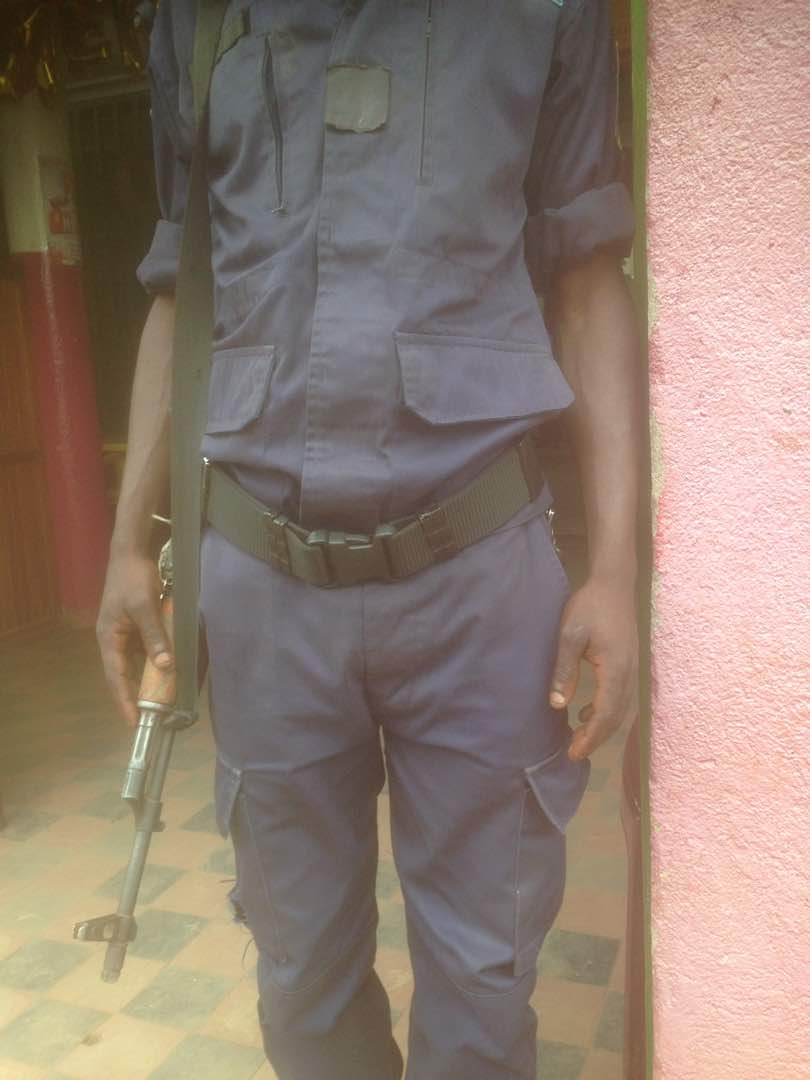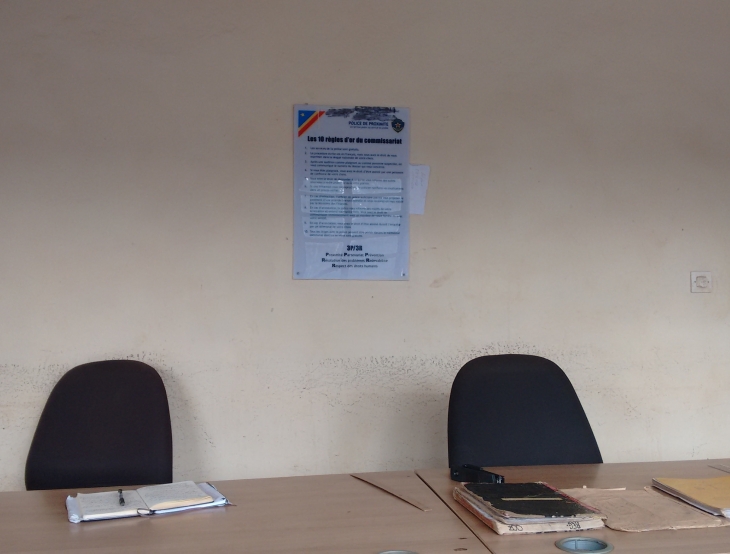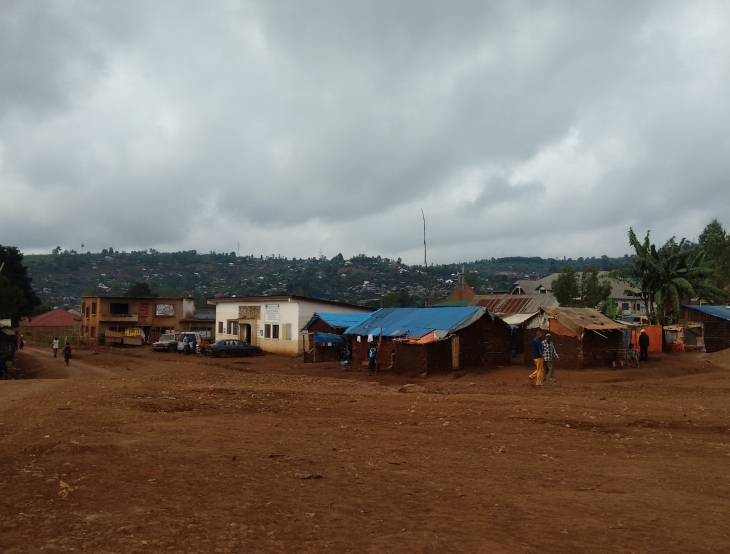The police uniform: A source of pride, misery and revenue
by Josaphat Musamba, Michel Thill and Robert Njangala
This blog is posted in French on the website of the Rift Valley Institute.
Introduction
See, the uniform of the policeman is his direct identification. When the policeman is in uniform, he is visible. You know immediately that he is police. And it is the uniform that immediately informs the population that this man is in charge of the protection of civilians and their goods. The mere act of wearing the uniform makes you identifiable by the population who is informed about what the police does in its midst.[1]
Across the world, uniforms carry an undeniable symbolic value. In security services, in prisons, hospitals, schools or sports clubs, they identify and differentiate. Military and police uniforms represent state authority, unite those who serve under their flag and demand respect and deference. The uniform’s symbolism, however, is not always positive for police officers in Bukavu, a city in the east of the Democratic Republic of the Congo (DRC). Working and living in difficult conditions, their uniforms play an ambiguous role in their struggle to overcome daily challenges. Sometimes, it reflects the police’s pride and commands respect. Other times, it stigmatizes, causes shame and insecurity, or facilitates supplementing their income.
Barometer of the police’s value in society
One day, we went to arrest someone. With us was a policeman who wore a dirty, torn and used uniform. Once we reached the place, the person in question refused to let this policeman enter his compound wearing this uniform. The other policemen entered the house, but he stayed outside in front of the door.[2]
For most police officers, wearing a uniform means representing their country. It symbolizes pride, respect and of authority over the population.[3] A police officer expressed this as follows: ‘So, in terms of the uniform, the colour of the flag, that is value, we have much more esteem. And now when someone arrives at a police officer’s home, he is at the home of a worker of the state.’[4]
In the city of Bukavu, due to the lack of provision of new police uniforms, they quickly deteriorate in the regular execution of police work, losing their positive symbolic value. A police officer identified the problem with these words: ‘Well, I have one single uniform or I have two, but they are torn. So even if I wash them, I will always look dirty, that’s the problem.’ [5] Another policeperson commented: ‘The policeman who wears a uniform torn around the buttocks, he takes a piece of fabric to patch it. You see, if you walk in front of a crowd like that, too dirty, it’s embarrassing. It makes a large wound in your heart.’[6]
A dirty and used uniform invites popular mockery and belittling, further decreasing the respect people have for the police. As a result, some officers only put on their uniforms when they arrive at the station.[7] Besides its psychological impact on police officers, the public’s lack of respect also complicates police work. A police officer mimicked the resistance and contempt they suffer at the hands of civilians: ‘You, policeman, who can you detain with such a dirty, used and torn uniform, which reveals your buttocks?’[8]
When relations between the police and the public deteriorate, the uniform can become a symbol of repression. A group of police officers mentioned that, during such periods, they do not walk around freely in uniform out of fear of revenge attacks by the population.[9]Another officer said that during a recent episode of serious police–community tensions in Bukavu following violent confrontations in the Cahi and Panzi neighbourhoods in September 2017, his neighbours brought civilian clothes to the commissariat so he could return home incognito. He explained: ‘When the population only sees a police uniform, immediately they think: “… these are thieves.” The image of the police was completely tarnished.’ As if to underline the symbolic importance of the uniform, he added: ‘Even when the police had not yet lost the public’s trust to this extent, when I am alone in uniform at night, I am not safe.’[10]
This sentiment of distrust, however, is often reciprocated. Several police officers said the public did not sufficiently collaborate with them. They complained that, ‘The population is dishonest.’[11]The uniform thus directly impacts the police officer’s daily work, his value in society and his perception of the public. Besides these symbolic characteristics, however, the uniform also carries a material value.

A source of revenue
Senior officers have access to commanders, and [when they see them] they can easily have a uniform because they are available at their offices in large numbers. It happens that senior officers are ordered to distribute uniforms, but they refuse to do so … in order to sell them for 10 or 20 dollars.[12]
As police uniforms are infrequently distributed to officers and, when they are, often according to favouritism, uniforms have become highly sought-after. Considering the internal logic of the police as a resource-generating institution, it may not be surprising that the hierarchy exploits this situation. A police officer explained that in 2016, ‘We were told that [the distribution of uniforms] was over, but uniforms began to be sold at 25 dollars. The new uniform. This created a controversy.’[13]But the traffic in uniforms—although illegal—is not limited to those higher up in the hierarchy. The low to non-existent salary also provides an incentive for lower-ranking officers to barter away their uniforms, sometimes with serious consequences. ‘I found myself with a well-kept uniform,’ explains one officer. ‘I sold it to a colleague. He gave me a mere 5 dollars, which helped my children. Then, at the office, they knew about it and put me in jail.’[14]
A uniform in a good state makes it easier for police to supplement their salaries. A police officer commented: ‘When I am in uniform, I know well that I will find money. Even without asking, someone who knows me gives me money when he sees me.’[15] Another was even more explicit: ‘On some days, it is just a matter of wearing the uniform and then I go shock [harass], I look out for [money] because it is pointless to stay home.’[16]
Conclusion
The uniform is an important part of the daily life of a police officer. It is a source of pride and respect. It reflects a feeling of patriotism and represents public order. The infrequent distribution, its misappropriation and the socio-economic conditions of the police, however, degrade the uniform’s symbolic value. A dirty and used uniform causes shame and tarnishes the police’s image. Its illicit trade reduces the uniform to mere merchandise. In other cases, it facilitates the search for revenue and harassment so much so that the uniform comes to represent ‘what’s wrong’ in the country for the public. For a population determined to take things into their own hands, a police uniform becomes a target. The image of the police and the police officer’s daily experience are thus directly linked to the uniform. By investing more into the police uniform, would it be possible to stimulate not only police officers’ daily motivation to pursue their work, but also promote their appreciation in society and, ultimately, improve police–community relations?
[1] Interview with police officer 1, 24 October 2017 (translated from French).
[2] Focus Group B, 2 November 2017 (translated from Swahili).
[3] Focus Group B, 2 November 2017.
[4] Interview with police officer 1, 9 November 2017 (translated from French).
[5] Interview with police officer 7, 29 October 2017 (translated from Swahili).
[6] Interview with police officer 1, 26 October 2017 (translated from French).
[7] Focus Group A, 2 November 2017.
[8] Focus Group B, 2 November 2017 (translated from Swahili).
[9] Focus Group C, 3 November 2017.
[10] Interview with police officer 1, 16 and 24 October 2017 (translated from French).
[11] Focus Group C, 3 November 2017 (translated from Lingala).
[12] Interview with police officer 7, 10 November 2017 (translated from Swahili).
[13] Entretien avec policier 1, 26 octobre 2017.
[14] Entretien avec policier 6, 24 octobre 2017.
[15] Focus Group A, 2 November 2017 (translated from Swahili).
[16] Interview with police officer 6, 24 October 2017 (translated from Swahili).


